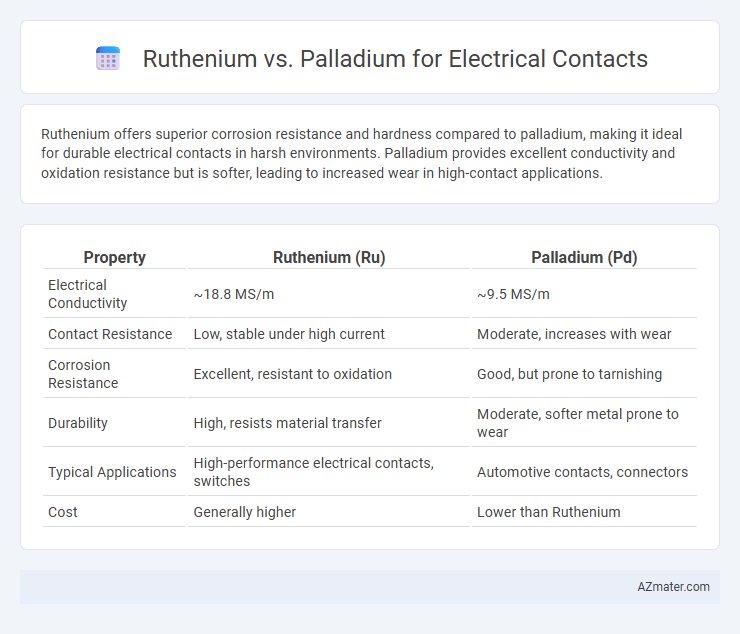Ruthenium offers superior corrosion resistance and hardness compared to palladium, making it ideal for durable electrical contacts in harsh environments. Palladium provides excellent conductivity and oxidation resistance but is softer, leading to increased wear in high-contact applications.
Table of Comparison
| Property | Ruthenium (Ru) | Palladium (Pd) |
|---|---|---|
| Electrical Conductivity | ~18.8 MS/m | ~9.5 MS/m |
| Contact Resistance | Low, stable under high current | Moderate, increases with wear |
| Corrosion Resistance | Excellent, resistant to oxidation | Good, but prone to tarnishing |
| Durability | High, resists material transfer | Moderate, softer metal prone to wear |
| Typical Applications | High-performance electrical contacts, switches | Automotive contacts, connectors |
| Cost | Generally higher | Lower than Ruthenium |
Introduction to Ruthenium and Palladium
Ruthenium and palladium are both transition metals widely used in electrical contacts due to their excellent conductivity and corrosion resistance. Ruthenium, a rare platinum group metal, offers superior hardness and wear resistance, making it ideal for high-reliability applications where durability is critical. Palladium, known for its excellent electrical conductivity and oxidation resistance, is commonly utilized in connectors and switches requiring stable performance under varying environmental conditions.
Material Properties Comparison
Ruthenium exhibits superior corrosion resistance and higher hardness compared to palladium, making it ideal for durable electrical contacts in harsh environments. Palladium offers excellent conductivity and is more ductile, which facilitates easier fabrication and reliable low-resistance connections. The choice between ruthenium and palladium hinges on balancing electrical performance with mechanical robustness and environmental stability.
Electrical Conductivity Differences
Ruthenium exhibits higher electrical conductivity than palladium, making it more efficient for reducing contact resistance in electrical applications. While palladium offers good conductivity and excellent corrosion resistance, ruthenium's superior electron mobility enhances signal transmission and minimizes energy loss in high-frequency circuits. This difference in conductivity directly impacts the performance and reliability of electrical contacts in advanced electronic devices.
Corrosion and Oxidation Resistance
Ruthenium outperforms palladium in corrosion and oxidation resistance, making it a preferred choice for durable electrical contacts in harsh environments. Its ability to maintain conductivity and mechanical integrity under high temperature and corrosive conditions reduces contact degradation significantly. Palladium, while offering good conductivity, is more susceptible to surface oxidation and corrosion, leading to higher maintenance and shorter service life in electrical applications.
Contact Wear and Durability
Ruthenium offers superior contact wear resistance compared to palladium due to its higher hardness and excellent corrosion resistance, extending the lifespan of electrical contacts in harsh environments. Palladium demonstrates good conductivity and resistance to oxidation but tends to exhibit greater material transfer and wear under high current loads. For applications demanding enhanced durability and minimal contact degradation, ruthenium-based contacts provide a more reliable solution over extended operational cycles.
Cost and Availability Factors
Ruthenium offers superior corrosion resistance and wear properties compared to palladium, but its cost is higher due to limited global supply and complex extraction processes. Palladium, while more abundant than ruthenium, has experienced price volatility driven by automotive industry demand and geopolitical factors affecting major producers. Selecting between ruthenium and palladium for electrical contacts requires balancing cost-effectiveness with availability constraints and performance requirements in specific applications.
Performance in High-Temperature Environments
Ruthenium exhibits superior performance over palladium in high-temperature electrical contacts due to its higher melting point (2334degC vs. 1554degC) and enhanced oxidation resistance, which ensures stable conductivity and reduced degradation under thermal stress. Palladium, while offering excellent corrosion resistance and good electrical conductivity, tends to suffer from increased contact resistance and material degradation at elevated temperatures above 200degC. Consequently, ruthenium is often preferred in applications requiring reliable electrical performance and longevity in harsh, high-temperature environments such as aerospace and industrial power systems.
Environmental and Safety Considerations
Ruthenium offers superior corrosion resistance and reduced wear in electrical contacts, minimizing environmental contamination from metal degradation. Palladium, while more abundant and less costly, poses higher risks due to its susceptibility to oxidation and potential release of toxic palladium compounds during manufacturing and disposal. Selecting ruthenium for electrical contacts enhances sustainability by extending component life and reducing hazardous waste compared to palladium-based alternatives.
Typical Applications: Ruthenium vs Palladium
Ruthenium is commonly used in electrical contacts for high-reliability applications such as aerospace connectors and precision sensors due to its excellent wear resistance and oxidation stability. Palladium, favored in automotive relays, telecommunications switches, and printed circuit board contacts, offers superior corrosion resistance and lower contact resistance. Both metals enhance electrical performance, but Ruthenium is preferred for durability under harsh conditions, while Palladium excels in environments requiring enhanced conductivity and corrosion protection.
Selection Guidelines for Electrical Contacts
Ruthenium outperforms palladium in electrical contacts due to its superior hardness, corrosion resistance, and stable electrical conductivity under high current loads. Palladium offers excellent conductivity and is more cost-effective but is prone to surface degradation and wear in high-stress applications. Selection guidelines favor ruthenium for contacts in harsh environments requiring longevity and reliability, while palladium suits less demanding, budget-sensitive uses.

Infographic: Ruthenium vs Palladium for Electrical Contact
 azmater.com
azmater.com